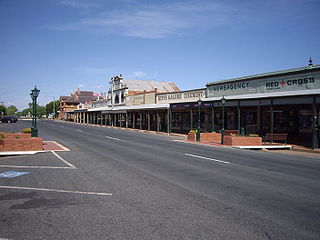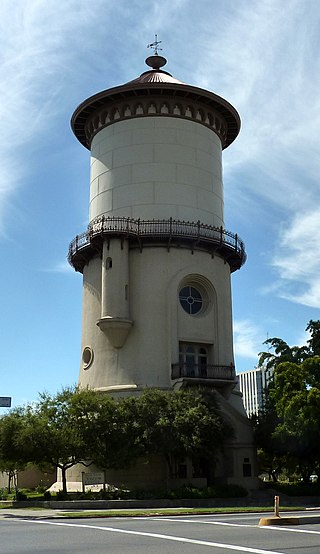
Osseo is a small city in Hennepin County, Minnesota, United States. As of the 2020 United States Census, it has a population of 2,688.

The Chicago Water Tower is a contributing property and landmark in the Old Chicago Water Tower District in Chicago, Illinois, United States, that is listed on the National Register of Historic Places. Built to enclose the tall machinery of a powerful water pump in 1869, it became particularly well known when it survived the Great Chicago Fire of 1871, although the area around it was burnt to the ground.

Lockhart is a town in the Riverina Region of New South Wales, Australia. It is the location of the Lockhart Shire Council offices. At the 2016 census, Lockhart had a population of 818 people.

Mount Crosby pumping station is a heritage-listed pumping station and weir at Stumers Road, Mount Crosby, City of Brisbane, Queensland, Australia. It is located on the Brisbane River and extends into Chuwar on the other side of the river. The facility supplies water to Brisbane and nearby cities and towns within the SEQ Water Grid. It was originally designed by Charles H McLay and built from 1891 to 1892. The historic parts of the facility were added to the Queensland Heritage Register on 25 October 2019. It is also listed on the Brisbane Heritage Register, together with numerous associated facilities which were not included in the state heritage listing.

The Beloit water tower is a historic octagonal limestone water tower completed in 1889 in Beloit, Wisconsin.

The Old Chicago Water Tower District is a historic district along the Magnificent Mile shopping district in the Near North Side community area of Chicago, Illinois. The district is located on both sides of North Michigan Avenue between East Chicago and East Pearson Streets. It includes the Chicago Water Tower, Chicago Avenue Pumping Station, and Chicago Fire Department Fire Station No. 98. All three structures are part of the Chicago Landmark district designated on October 6, 1971. The Water Tower and Pumping Station were jointly added to the National Register of Historic Places on April 23, 1975. In addition the Tower was named an American Water Landmark in 1969. The Water Tower was also one of the few buildings to survive the Great Chicago Fire. The district is the namesake of the nearby Water Tower Place.
Rockford is an unincorporated community and former town in southern Surry County, North Carolina, United States.

Mogollon, also called the Mogollon Historic District, is a former mining town located in the Mogollon Mountains in Catron County, New Mexico, United States. Located east of Glenwood and Alma, it was founded in the 1880s at the bottom of Silver Creek Canyon to support the gold and silver mines in the surrounding mountains. The "Little Fannie" mine became the most important employer for the town. During the 1890s, Mogollon had a transient population of between 3,000 and 6,000 miners. Because of its isolation, it had a reputation as one of the wildest mining towns in the West. Today Mogollon is listed as Fannie Hill Mill and Company Town Historic District on the National Register of Historic Places.

The Lena Water Tower is a water tower located in the village of Lena, Illinois, United States. It was built in 1896 following two decades of problems with structure fires in the village. The current water tower is the result of a second attempt after the first structure proved to be unstable. The tower stands 122.5 feet (37.3 m) tall and is built of limestone and red brick. The current stainless steel water tank holds 50,000 gallons and replaced the original wooden tank in 1984. The site has two other structures, an old power plant building and a 100,000 US gallon reservoir. The Lena Electric Plant Building was constructed in 1905 and the reservoir completed in 1907. The Lena Water Tower was listed on the U.S. National Register of Historic Places in 1997; the reservoir was included as a contributing property to the listing.

The Bethlehem Waterworks, also known as the Old Waterworks or 1762 Waterworks, is believed to be the oldest pump-powered public water supply in what is now the United States. The pumphouse, which includes original and replica equipment, is located in the Colonial Industrial Quarter of downtown Bethlehem, Pennsylvania, between the Monocacy Creek and Main Street. It was declared a National Historic Civil Engineering Landmark in 1971, an American Water Landmark in 1971, and a National Historic Landmark in 1981. The building is a contributing property to the Historic Moravian Bethlehem District which was designated as a National Historic Landmark District in 2012 and later named to the U.S. Tentative List in 2016 for nomination to the World Heritage List.

The Chillicothe Water and Power Company Pumping Station is a historic building on the northern side of Chillicothe, Ohio, United States. A Gothic Revival structure built in 1881, it was constructed to house the city's waterworks and power plant. Its architecture and its location in Yoctangee Park was chosen specifically in order to beautify the park as well as to have a location near other elements of the city's first waterworks, which were built at the same time as the pumping station.

1879 Houston Waterworks is a building located in Houston, Texas listed on the National Register of Historic Places.

The Monroe Water Tower is a historic water tower built in 1889 in Monroe, Wisconsin. It was added to the National Register of Historic Places in 2005.

The Evansville Standpipe is a historic water tower located in Evansville, Wisconsin. The 80-ft tall steel tower was built in 1901 by the Chicago Bridge & Iron Company, as part of the development of the local water supply system, spurred on by a devastating fire in 1896 that destroyed a large section of downtown Evansville. It was added to the National Register of Historic Places in 2008.

The Old Fresno Water Tower is a historic water tower in Fresno, California. It is listed on the National Register of Historic Places. Designed by George Washington Maher, the tower was completed in late 1894. It ceased operation in 1963 and has served as a visitors' center since 2001.

Grand Mound Town Hall and Waterworks Historic District, also known as Hose house, pump house, is a historic district located in Grand Mound, Iowa, United States. It was listed on the National Register of Historic Places in 2001. The district is composed of two buildings and the town's water tower.

Renwick Generating Plant, also known as the Municipal Steam Light Plant, is a historical industrial facility located in Renwick, Iowa, United States. G.L. Long was an engineer who was contracted in 1914 to design a steam-powered electrical light plant. It first distributed energy on March 14, 1915, at 6:00 p.m. The steam engines were replaced by a 75-horsepower, two-cylinder, semi-diesel engine and generating equipment manufactured by Fairbanks-Morse in 1922. A 125-horsepower diesel engine manufactured by Worthington Pump and Machinery Corporation was added in 1936. At that time the plant started to supply power to a newly formed rural electric cooperative that was funded by the Rural Electrification Act of 1936. A Faribanks-Morse 300-horsepower, four-cylinder diesel was added in 1939, and the 75-horsepower and 40-horsepower engines were replaced in 1942 by another 300-horsepower diesel. An addition was added onto the north side of the building the same year. It housed the local fire department and city hall. The facility was listed as a historic district on the National Register of Historic Places in 1995.

The West Water Tower and Ground Storage Tank are a historic water tower and storage tank located at 310 11th Avenue in Orion, Illinois. The tower and tank were built in 1928 as part of the village's new water system, which had been approved the previous year. The water system was introduced both as a response to several fires which had plagued the village and as an effort to bring modern technology and progress, among other civic concerns. The water tower consists of a steel tank with a hemispherical bottom supported by a steel trestle; the structure is 136.5 feet (41.6 m) tall. The ground storage tank, located at the base of the tower, is made of redwood and holds 30,000 US gallons of water.

The Sauk City Fire Station, begun in 1862, housed the city's early fire department, and served as a center of the community. Today it is one of the oldest fire stations in Wisconsin. It looks much like it did in 1870 - a gable-roofed building with a hose-drying tower. It was added to the National Register of Historic Places in 1999.

Towering over the City of Bunnell is the city's most visible and iconic landmark: the City of Bunnell elevated steel water tower. The water tower is located at 100 Utility Street, Bunnell, FL 32110. It was built in 1926 by Chicago Bridge & Iron Company as part of a new waterworks system for Bunnell that went into operation in December 1927 and has been providing water to residents and local businesses to this day. The water tower is 110 feet high and its elevated steel tank holds 75,000 gallons of water. The elevated steel water tank has a conical top, Horton hemispherical bottom and is supported by four steel columns (legs) and reinforced with steel cross braces. The east and west sides of the elevated tank have black painted signage that read “City of Bunnell, Crossroads of Flagler County”























